New Beginnings

Has this happened to you?
I want to start a new chapter in art-making, change direction, and feel the excitement again.
Some say that this “new-beginning-thinking” is a thread for their artistry. That their problem is not to stick with one thing long enough so that the work is more coherent.
But new beginnings are built within creativity. Like nature, we need a new season now and then. In spring, trees begin to grow new leaves, and meadows new flowers. When nourished, they grow stronger and more beautiful year by year.

My new class Floral Freedom is this kind of creative nourishment. You will start building your visual language all over again. I teach both in theory and practice what I have learned from the two master abstract painters Paul Klee and Wassily Kandinsky.
Floral Freedom combines the intellectual and the emotional side so that you will wholeheartedly enjoy painting again. You won’t copy photos but use abstract techniques to express the flowers of the soul.
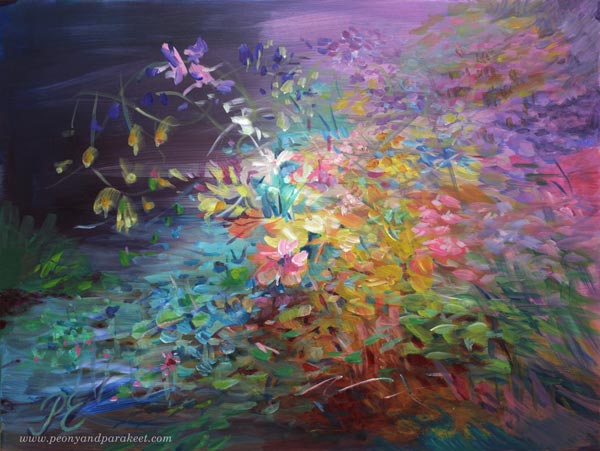
Yes, it will be a new beginning.
You will gather your paints and look at them from a new perspective.
You will paint lines and shapes with Paul’s and Wassily’s point of view.
You won’t see flowers right from the beginning but still end up with a floral painting!
You will stop dividing what’s abstract and what’s concrete,
and your art will grow from those insights.
The beginning that builds the foundation is never a thread but a strength.
We often wait for the right time to the new beginning. It’s easy to postpone it, I know. My mother passed away with too many regrets. The time never seemed to be right. A new beginning would always be somewhere in the future.
I have had a similar problem with Floral Freedom. I have wanted to build this class since 2016, after reading Paul Klee’s Pedagogical Sketchbook. But there have always been excuses – what I am capable of and what’s appropriate and safe. This summer, I even planned not to build a new class at all. I have made so many of them already.
But then I heard me saying:
“Don’t leave without teaching what you have got from Paul and Wassily! You’ll always regret not doing that!”
And yes, the better time for the class may come, but this is also a fact:
new beginnings don’t wait forever.

As you see, Floral Freedom is a very special class. I hope you will join me, pick the paints and brushes, and give yourself the joy of a new beginning.
Black Friday Week Sale
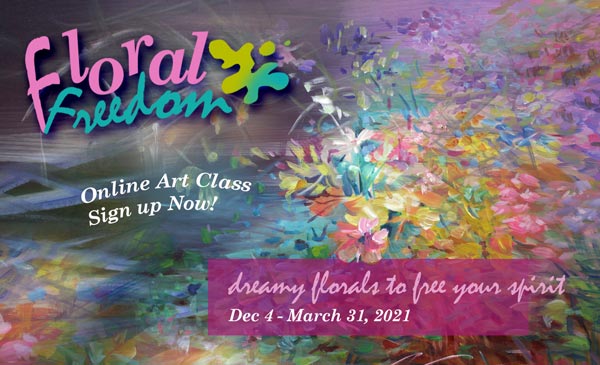
Floral Freedom is 20% off.
The sale ends on Monday, Nov 30, midnight PST.
The class begins on Dec 4.
>> Sign up now!
Impressionistic Floral Painting on Structure Paste
This week, I show how I made an extraordinary floral painting with acrylics and structure paste. See how I achieved the historical look!
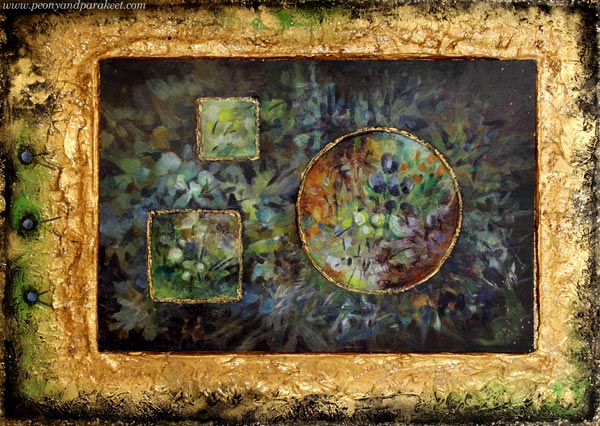
I call this piece “Old Art Yearning” because I desperately miss Europe’s palazzos and museums. It would definitely be the time to pack the bags for a few-day trip to Vienna or some other old city, but I chose differently because of the pandemic. But first, look at the interior of Palazzo Doria Pamphilj in Rome. My husband and I visited the place on June morning in 2017, and it was pleasantly quiet, just suitable for dreaming about living there in the middle of luxury.
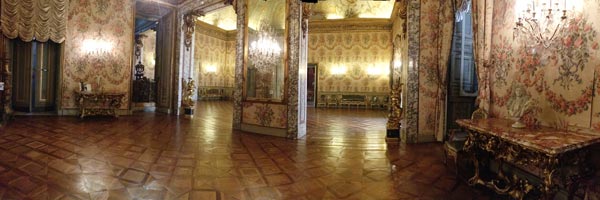
So, what luxurious can you do when you are asked to stay home and be safe? I decided to create something that’s like a soft drink for the old art thirst: fake but sweet and consolating!
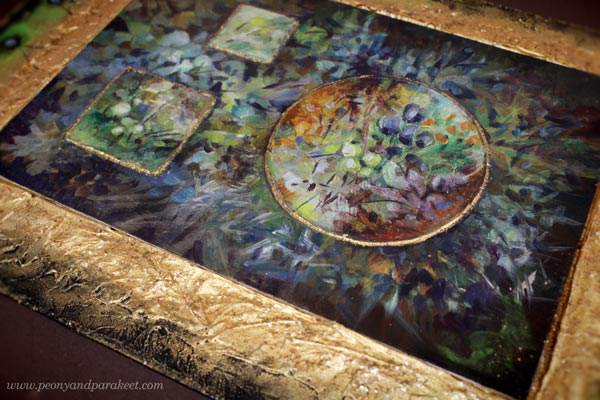
The idea of using structure paste is from the summer, but back then, I didn’t quite see as far as I did this week.
Structure Paste Inspiration from Clay
This summer, my friend Johanna Rytkölä, a ceramic artist ran a flower pot class for a small group. My husband made a stylish and minimalistic bonsai pot, but mine came out quite different!
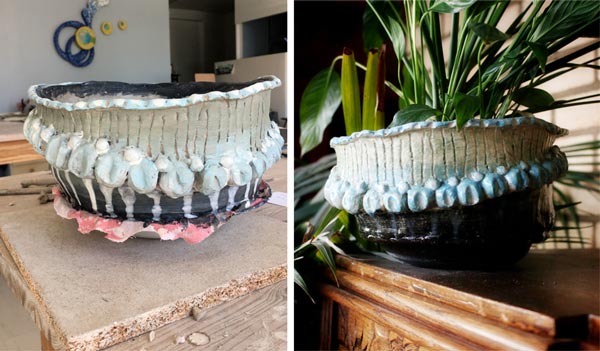
Even if my pot was not perfect, I wanted to experiment with a 3-dimensional surface for a painting right away. I dig out a jar of structure paste that some call molding paste as well. I have blogged about the paste twice before. In 2014, I made cardboard templates to create reliefs for a mixed media piece and in another project, I made surface textures with a variety of tools.
I decided to try the template technique again, and cut simple geometric holes to a thick cardboard.
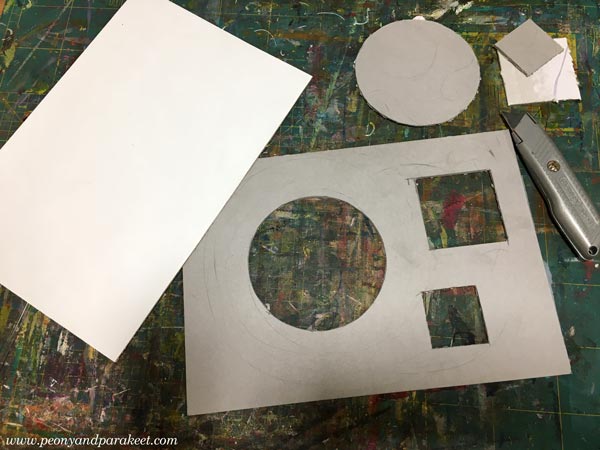
Then I placed the template on the top of the painting board and filled the holds with structure paste.
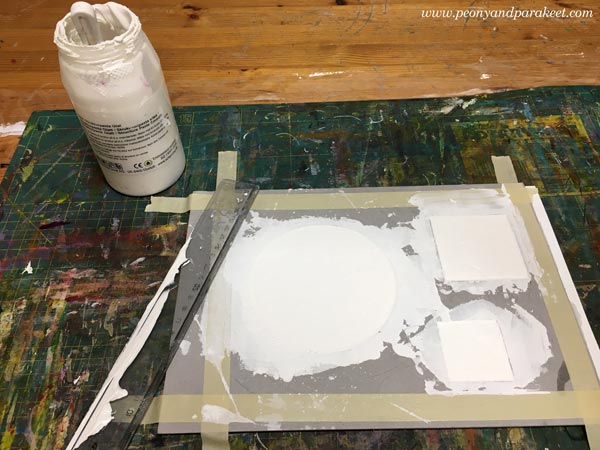
I wasn’t completely satisfied with the edges of the structure paste shapes and put the board away.
Acrylic Painting on Structure Paste
But now, when I wanted to create something with historical feel, I remembered the board, and started painting on it. The small imperfections didn’t bother me so much anymore. All pieces can’t be so serious anyway. There has to be some room for creative play too!
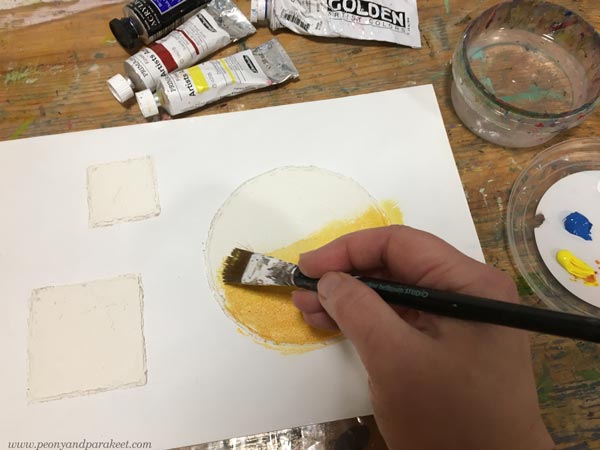
I decided to paint something loose and impressionistic that would still look decorative.
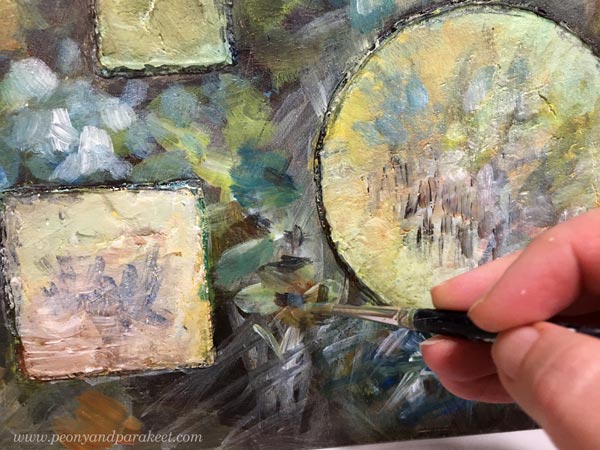
On the reliefs, the strokes were sharper and more controlled than on the background.
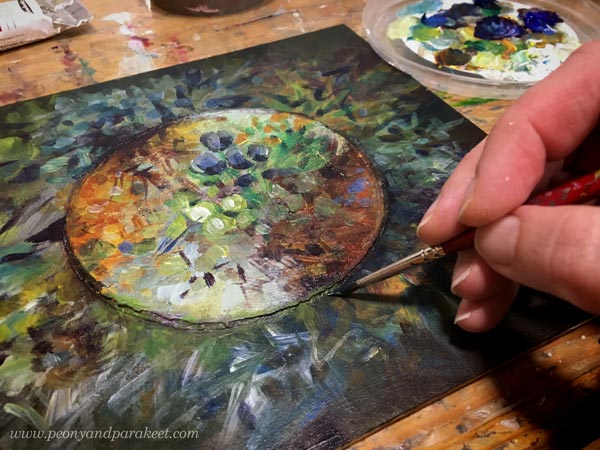
But before I made the finishing touches, the piece looked too bare to me.
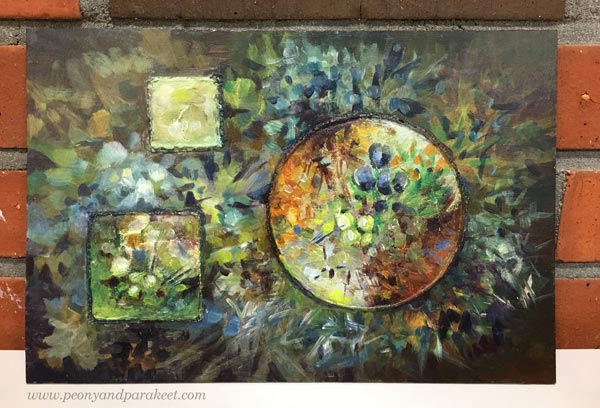
It needed a frame!
Making a Frame from Structure Paste
I still had some structure paste left and I found a piece of cardboard too. I traced the outline of the painting on a soft foam board and used that as a template for the center.
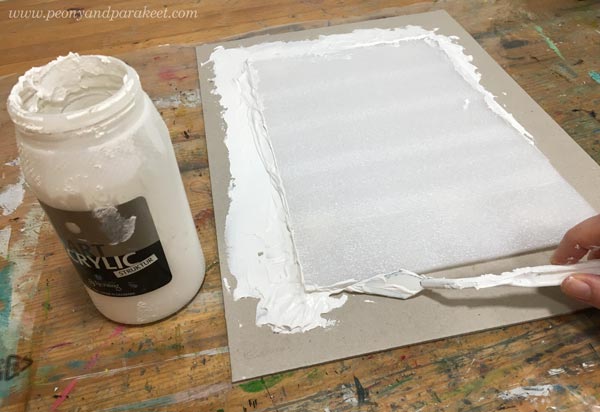
It’s not easy to make a smooth surface of the paste so I didn’t even try. Historical frames had all kinds of textures so the hills and valleys would look ok when painted.
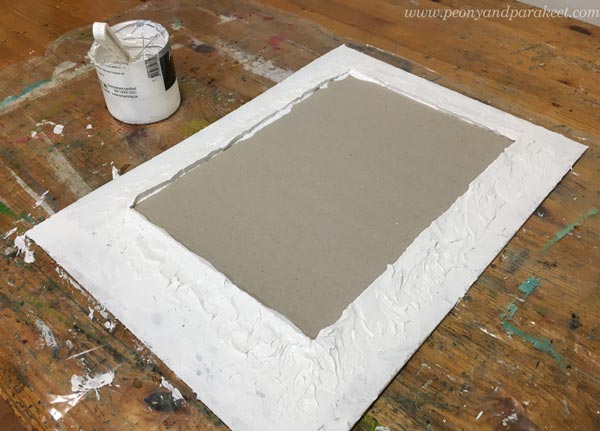
I painted the outer edge of the frame black and the inner edge with gold paint.
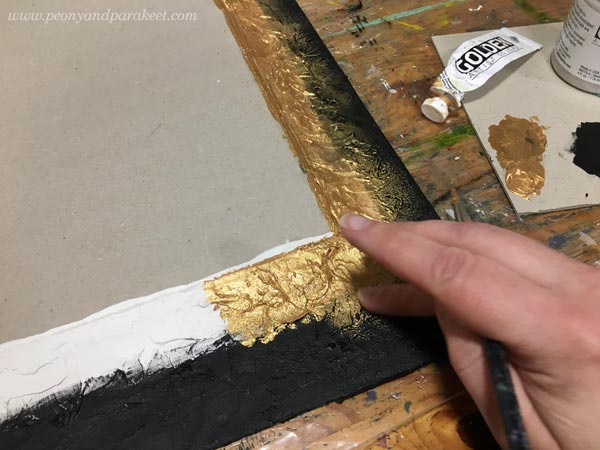
The transition from black to gold became lovely when smudging the paint with fingers. I also added some gold mica flakes on the top of the gold parts and near the edge.
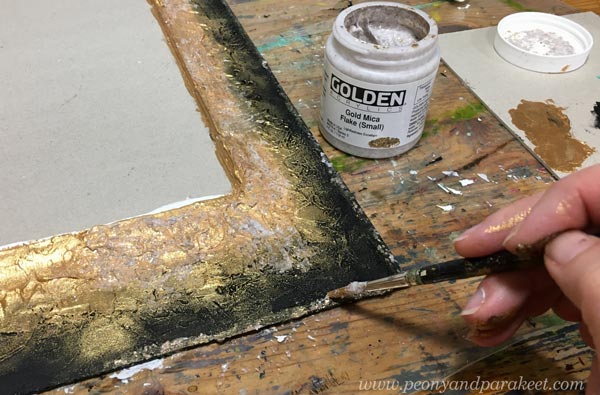
Then the painting got some finishing touches and gold paint too.
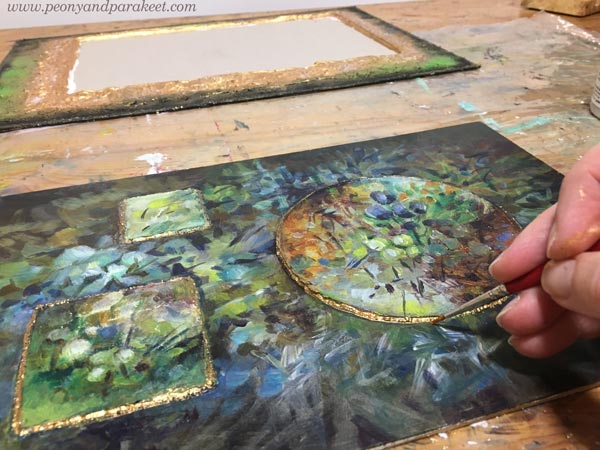
I also added some acrylic paint on the frame.
A Mini-Monet for Old Art Yearners!
The finished piece is a bit clumsy, but I love the historical feel.
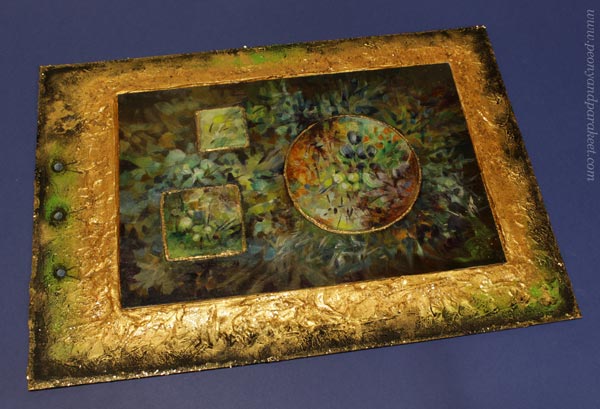
It’s my mini-Monet!
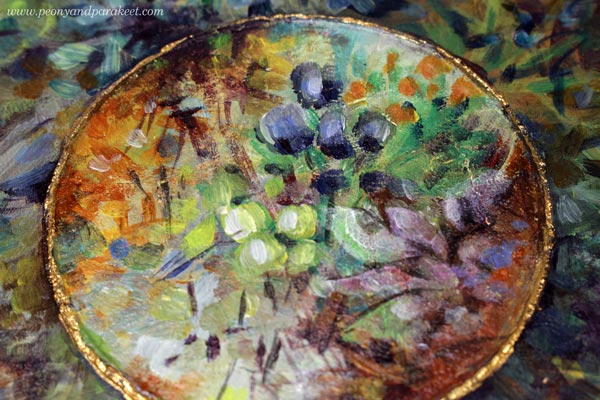
The unevenness of the structure paste in the edges looks quite good with the gold paint.
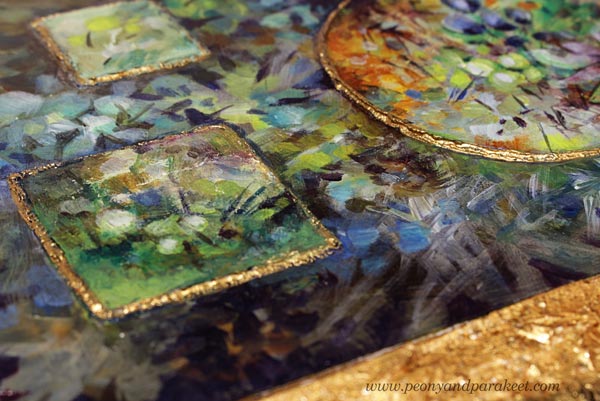
The frame was intentionally placed so that it’s not quite in the middle. This way I could make the piece more interesting. I really like how these painted spots look like nails or blueberries!
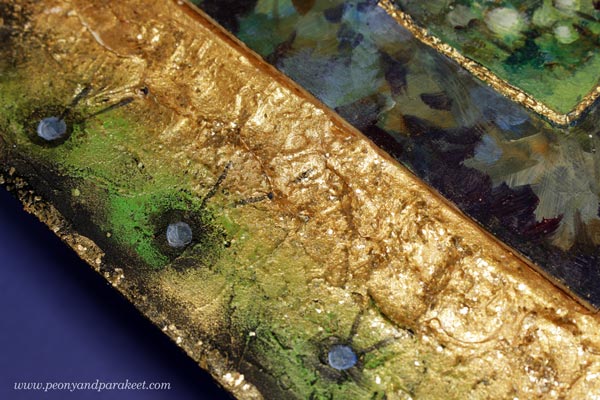
Just cardboard, structure paste, fake gold, acrylics, but I enter the gentle world of old art by looking at it!
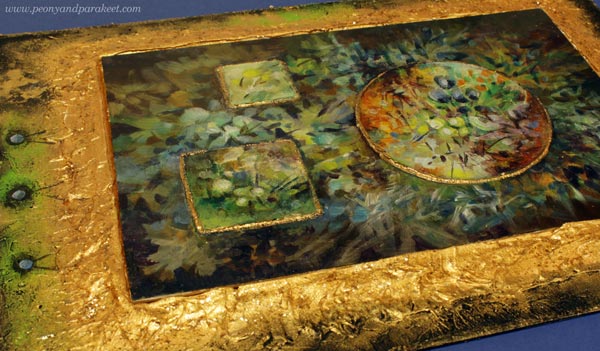
I display this piece in our library room which has more old-fashioned style than my studio.
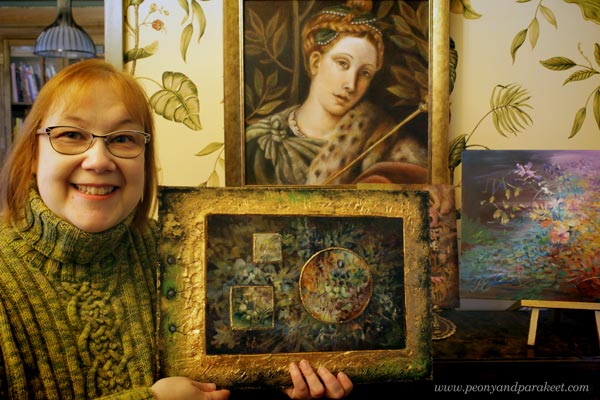
My painting has simple strokes but it’s still romantic. I have bent the principles of abstract art to serve the impressionistic style. It’s so much fun to paint freely like this!
Paint Dreamy Florals to Free Your Spirit!
Floral Freedom – the floral class based on Paul Klee’s and Wassily Kandinsky’s insights on abstract art – will begin on Dec 4, 2021. In this class flowers are not just passive decorations, but they fly, sing, and dream! >> Sign up Now!

Floral Freedom is 20% off for the rest of November, so now is a good time to sign up!
>> Sign up now!
Painting Poems – Watch the Video!
This week, we’ll continue the theme of painting poems from a couple of weeks ago. I create a small painting from a poem in a video and also talk about overcoming perfectionism.
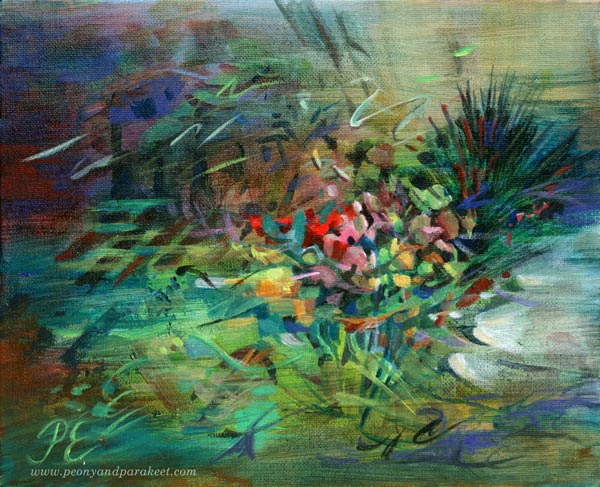
Here’s the acrylic painting that I created from Saima Harmaja‘s old poem “Olkoon niin!” I also include some examples from the class Floral Freedom at the end of this post.
Painting Poems – Watch the Video!
In the video, I show how a poem can make a painting more finished and meaningful. I also talk about why I thought I can’t paint Finnish poems and how I have realized that aiming for perfection doesn’t always help.
More Poetic Paintings
I created these two paintings for the class Floral Freedom. The first one is inspired by Anna-Maija Raittila’s poem Ruiskukkaehtoo (Cornflower Night).
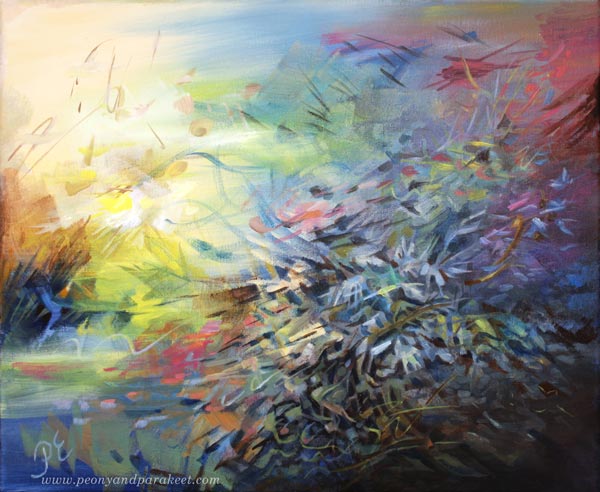
And the one below is inspired by Katri Vala’s poem Kukkiva maa (Flowering Earth).

Paint Dreamy Florals to Free Your Spirit!
Floral Freedom – the abstract floral class based on Paul Klee’s and Wassily Kandinsky’s insights – will begin on Dec 4, 2021. In this class flowers are not just passive decorations, but they fly, sing, and dream! >> Sign up Now!

Floral Freedom is 20% off for the rest of November, so now is a good time to sign up!
>> Sign up now!
Using Leftover Paint – Messy Backgrounds and Beyond
This week, I show one of my art journals in the video and share ideas for what to create from messy backgrounds.
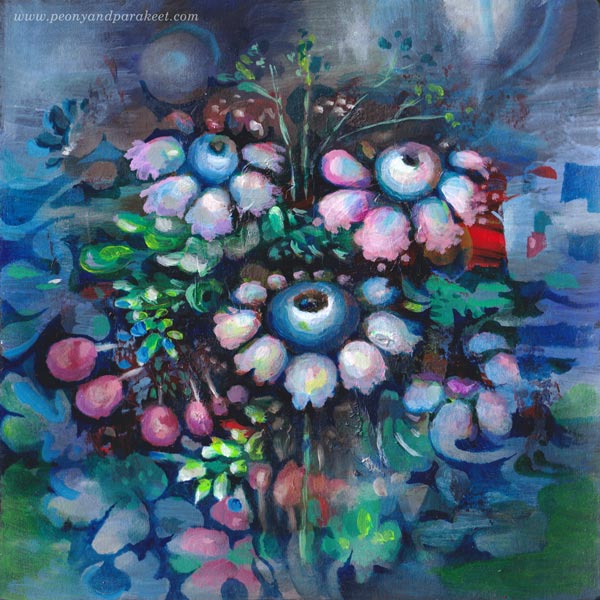
After a painting session, there’s usually some leftover paint on a palette. I try to squeeze the tubes carefully, and sometimes I put the paint in a box with a lid, but most often, I grab an art journal and wipe off the extra paint from the brushes and palette. If I am tired, I just spread the paint carelessly. If I still have energy, I add details to a page that already has some color. When I don’t like something in the next session, I paint new strokes over it.
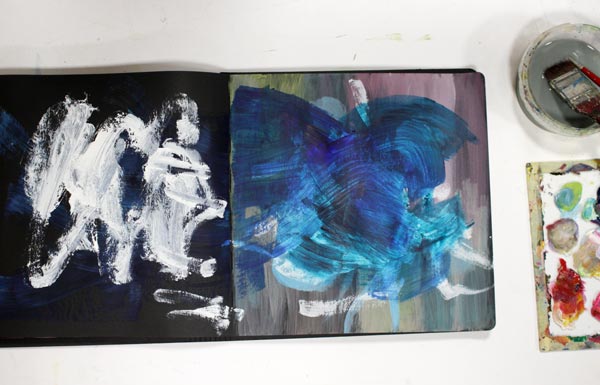
Many Rounds – Some Quicker than Others
I rarely make a page at one go. This spread has oil paints, and it took ages to finish it. But it didn’t matter, because I was practicing for the class Decodashery, and I needed time to dig into the heart of decorative painting style.
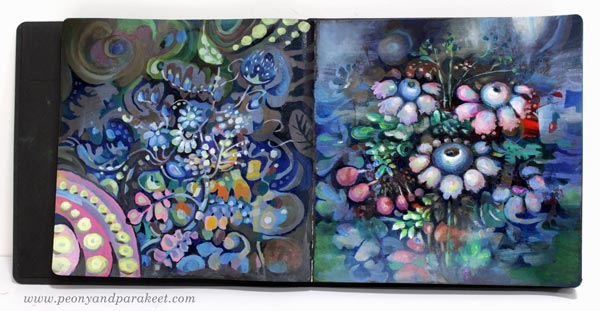
However, the one below is more abstract, and it was really quick!
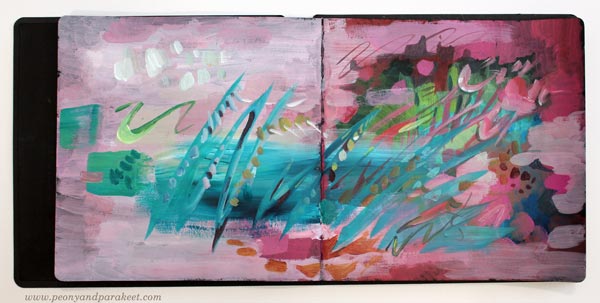
Messy Backgrounds and Beyond – Watch the Video!
In the video, I show messy pages and not so messy pages of my current art journal and how I finished the spread above. Watch the video!
Even if bigger paintings are my main work, art journal pages are an important part of my creative process. It’s like yin and yang! I need the mess-making to find joy in working with details.
Art Inspired by Music
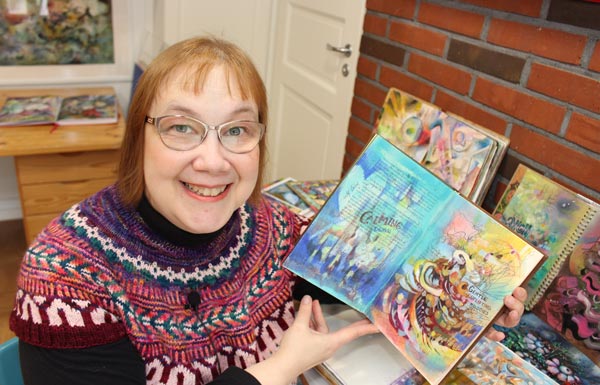
In the video, I mentioned the idea of visualizing a musical landscape and a melody. Music is the theme in my mini-course for Gratitude Junk Journal 2020 as well. This online workshop has 12 instructors, and it begins on Nov 1st, 2020. Register in October to get 20% off. Enter JOY2020 at checkout. >> Buy Here!